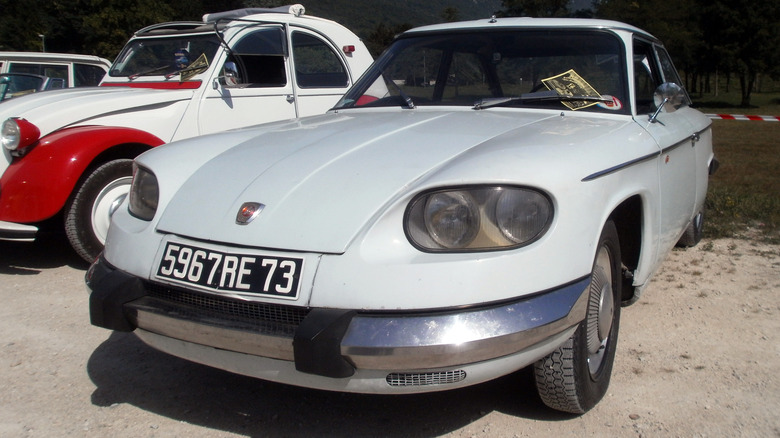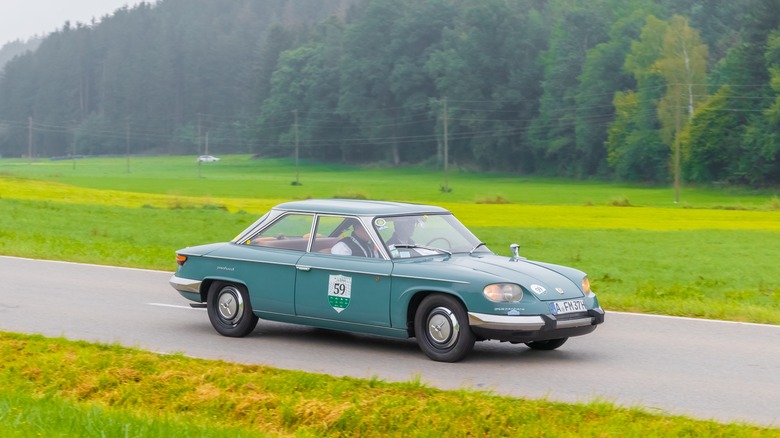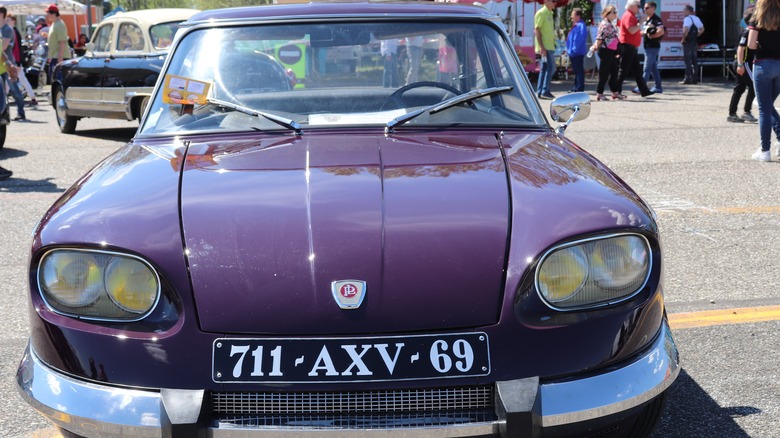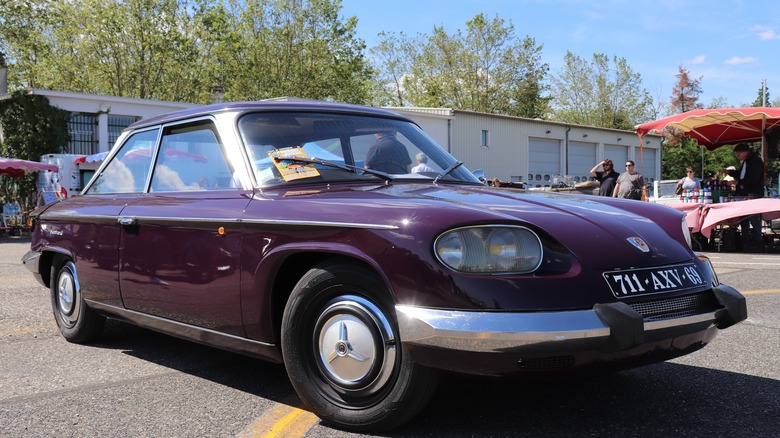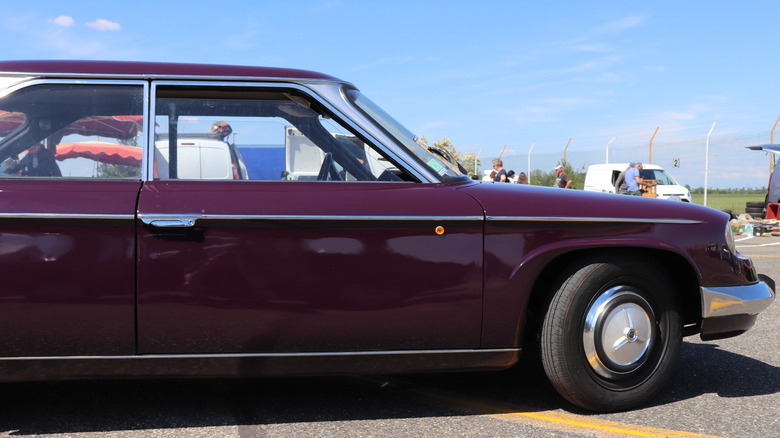This Little Known French Classic Makes The VW Beetle Look Like A Toy
A lot of petrolheads, when asked to name their favorite iconic car, will surely begin singing the praises of a sleek, beautiful sports car; perhaps with a formidable engine, flawless gleaming color scheme, and monstrous specs. Iconic, however, doesn't necessarily mean any of these things. The Volkswagen Beetle doesn't exactly glow with any of these virtues (though some of them do sport some eye-catching paint jobs), but it's certainly a model that even those who aren't particularly interested in cars can instantly identify at a distance.
Few vehicles in automobile history are as familiar and ubiquitous as the Beetle. Volkswagen reported in 2022 that over 23 million of them sold to enthusiasts of the curvaceous, practical ride over its long production lifetime. For every tremendous success story like this, though, there will typically be several similar offerings that just didn't rise to the same heights. In the case of the iconic VW Beetle, one example would be France's majestic Panhard 24 BT.
If you've never heard of it, you're not alone, and it's not a slight on your auto-loving credentials. Though it might not have a design as identifiable as the Beetle, it's a similar machine in a lot of ways, and one that even has qualities above and beyond those of the legendary Bug. Here's a closer look at the Panhard BT, its origins, and just why the Beetle comparison is so apt. If underrated-yet-impressive vehicles are your thing, this one's certainly for you.
A short history of Panhard and the 24 BT
Vehicles, it seemed, were in the blood of the Panhard family. During the course of the early-to-mid eighteenth century, the coach business of François-René Panhard developed into one that dealt in carriages under the guidance of his son — Adrien Panhard. By 1888, the then-Panhard and Levassor brand had a license for Daimler engines, and François-René's grandson became an early innovator in the exciting developing field of motorized vehicles.
The brand's first exclusively in-house developed model — the Système Panhard — was completed in 1891, boasting a V2 Daimler engine in the front, a very wood-heavy body, and an awful lot of potential. Panhard would struggle in the post-World War II landscape of over 50 years later, but through the bold move of a sort of resource-sharing alliance with fellow French automaker Citroën in the mid-1950s, fought on. Early in 1965, it would become a part of Citroën and cease developing its own civilian vehicles, but this era of the company also produced the enigmatic, oddly beautiful, fascinating 24.
Debuting in 1963, and designed by the company's own Louis Bionnier, it was originally a lightweight and compact coupé in its 24 C guise. The next year, the 24 B, or "Berline," joined its ranks. Had things worked out differently, it may have revived Panhard's fortunes in the market and dominated popular culture, as Volkswagen's Beetle went on to do in its stead.
The specs of the Panhard 24 B and C
The uninitiated may wonder about the difference between the 24 C and B. The C marks the vehicle out as a coupé, while Berline is the French term for a sedan. The original 1963 coupé was available in two guises: The Panhard 24 C and the 24 CT. Both, of course, are four-wheel-drive coupés with 51.7 cubic-inch engines, but they differed somewhat in terms of raw specs. The standard C boasted 51 lb-ft of torque, 50 horsepower, and a top speed of 81 mph.
The '63 CT, meanwhile, was the deluxe model; pumping those numbers up a little to 59 horsepower, with a top speed of approximately 93 mph and increased torque of 56 lb-ft. Meanwhile, the '63 Volkswagen Beetle's own 1,192cc engine offered 64 lb-ft of torque and approximately 40 horsepower. Though the Beetle famously adopted the sedan guise, it would be another model year before Panhard's 24 B did the same. The '64 B had a engine of equal capacity to the C, resulting in equal specs for the B and C, as well as the BT and CT — though the sedan variant offered slightly different top speeds of around 86 mph and 90 mph, respectively.
Plainly, the 24 was more than competitive with Volkswagen's famous export. One thing that sets the two vehicles apart even more, though, is their respective designs. The philosophies, and their results, were markedly different.
What's so unique about the Panhard 24's design?
This model had to be a real departure so as not to cannibalize anything that Citroen had or would have on offer. The answer to this, for the design team of Louis Bionier, was to create a smaller and more unique alternative to a sedan with four doors. Unique would certainly prove to be the operative word: Eccentric flair such as fins were initially conceptualized for the model (something like the '64 Panhard LM64 perhaps), but ultimately rejected. Even so, the 24 coupé still retained a fascinating flair, with its prominent headlamps, gleaming bumper, and the raised flat roof.
The next step was the Berline, a model that determined the best way to avoid making a four-door sedan was to lengthen the 24 and make it a two-door. The 24 B was revealed in October 1964, a variant 25 centimeters (approximately 9.8 inches) longer than the original. Approximately 63.9 inches wide and 167.7 inches long, it was over three inches wider and around seven inches longer than the Beetle 1200 of 1964.
As noted in a July 2021 episode of Jay Leno's Garage, dedicated to his beloved '67 Panhard 24 BT, the engine itself is very unusual. "The mechanicalness of this engine intrigues me, with the torsion bars ... the air-cooling, the hemi head, the roller bearing crank, even the connecting roads are on roller bearings. You've got two sets of rollers, one big, one small. It's just fascinating, the engineering that went into this thing."
What became of the Panhard 24?
Europe has a history of manufacturing some particularly interesting cars. Some, like Citroën's own DS, have been stylish, powerful, innovative, and sometimes underappreciated in a global sense. This same fate befell the Panhard 24, which was seemingly not heavily exported. In that same episode of Jay Leno's Garage, the host explains just how rare the 24 BT may be in North America now. According to the host, "this is truly a rare car ... I don't think there's probably more than a dozen of these in the States."
Considering the position that Panhard was in at the time, it was rather unlikely that the 24 would have had much of a chance at dominating the world or popular culture in the same way Volkswagen's Beetle did. Hemmings reports that a total of 28,651 models in the 24 family were produced, but also that it had such a limited time to make an impact: 1967 was the end of the line for the 24.
The Panhard company has a long history in military vehicles, having developed World War I transportation and weaponry. After its time with the 24 and civilian motor vehicles in general came to a close, the company returned to this, with the likes of the Panhard M3 HOT, an armored transport that was developed for 15 years from 1971. The 24 will remain one of the sorely underappreciated coupé and sedan models in the company's history.
